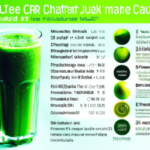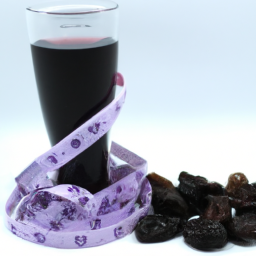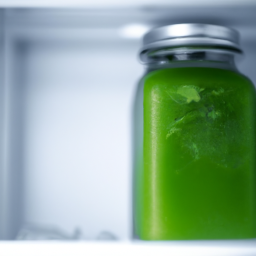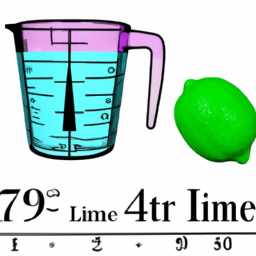As a dietitian, I am often asked, ‘How many calories are in green juice?’
It’s no surprise that people are curious about the calorie count in this popular health drink, as many are turning to green juice as a way to improve their overall health and wellness. In this article, I will provide an evidence-based analysis of the nutritional content of green juice and its calorie count, as well as discuss the benefits and risks of incorporating it into your diet.
To understand the calorie count in green juice, we must first examine its ingredients. Green juice typically contains a combination of leafy greens, fruits, and vegetables, which are all low in calories and high in nutrients. However, the calorie count can vary depending on the specific ingredients used, as well as the serving size and type of juicer used.
By breaking down the ingredients and analyzing their effect on the calorie count, we can gain a better understanding of how green juice fits into a healthy diet.
Key Takeaways
- The calorie count of green juice varies depending on the specific ingredients used, serving size, and type of juicer used.
- Vegetables are the main source of nutrients and generally low in calories, while fruits like apples and pineapples add sweetness and calories to green juice.
- Adjusting serving size and ingredients can have a significant impact on the nutritional value and calorie count of green juice.
- Green juice should be consumed as part of a balanced diet and in moderation, based on the recommended intake of fruits and vegetables.
Understanding the Ingredients in Green Juice
So, you want to know how many calories are in your green juice? Well, let’s first take a look at the ingredients and what they bring to the table for your health.
Green juice is typically made up of a variety of nutrient-dense fruits and vegetables, such as kale, spinach, cucumber, celery, and apples. These ingredients are rich in vitamins, minerals, antioxidants, and fiber, which can provide numerous health benefits, such as improving digestion, boosting immunity, and reducing inflammation.
In addition to the ingredient benefits, the juicing technique used to extract the juice can also impact the nutritional content and calorie count. Cold-pressed juicing, for example, uses a hydraulic press to extract the juice from the fruits and vegetables, which can help to retain more of the nutrients and enzymes compared to other methods, such as centrifugal juicing.
However, this method can also result in a higher calorie count due to the increased amount of pulp and fiber in the juice. Now that we understand the ingredients and juicing techniques, let’s take a closer look at how they affect the calorie count.
How Ingredients Affect Calorie Count
You’ll be surprised at how much the ingredients can impact the number of nutrients you’re consuming with each sip, whether it’s the sweetness of fruit or the earthiness of vegetables. When it comes to green juice, the ingredients used can greatly affect its calorie count. Here are some examples:
-
Fruits: Fruits like apples and pineapples are commonly added to green juice for their sweetness. However, these fruits also add calories to the drink. An apple, for instance, contains around 95 calories, while a cup of pineapple has about 82 calories. If you’re looking to keep your calorie intake low, it’s best to limit the amount of fruit you use in your green juice.
-
Vegetables: Vegetables are the main source of nutrients in green juice and are generally low in calories. However, some vegetables like carrots, beets, and sweet potatoes can add more calories to the drink due to their natural sugar content. For example, a cup of chopped carrots has around 52 calories, while a cup of cooked beets has about 59 calories. It’s important to balance the amount of vegetables and fruits in your green juice to keep the calorie count in check.
-
Juicing techniques: The way you juice your ingredients can also affect the calorie content of your green juice. For instance, using a centrifugal juicer may extract more pulp, which can add more calories to the drink. On the other hand, using a masticating juicer may extract more nutrients while producing a lower calorie count.
Understanding how ingredients and juicing techniques affect calorie count is crucial in creating a balanced and nutritious green juice. But it’s not the only factor to consider. In the next section, we’ll explore how serving size can impact the calorie count of green juice.
Serving Size and Calorie Count
When it comes to determining calorie count in green juice, serving size plays a crucial role. A standard serving size for green juice is usually 8-12 ounces, but it’s important to adjust the serving size based on personal dietary needs.
To accurately calculate calorie count, using a calorie counter tool can be helpful in determining how many calories are in each ingredient and the total calorie count of the finished product.
Standard Serving Size
The typical serving size for green juice is about 8 ounces. This amount of green juice contains varying amounts of nutritional value, depending on the ingredients used to make it.
Green vegetables such as kale, spinach, and cucumber are typically low in calories, but high in vitamins and minerals that are essential for good health. However, if the green juice includes fruits such as apples or bananas, the calorie count will be higher due to the natural sugars present in these fruits.
As a registered dietitian or nutritionist, I’d recommend consuming green juice as part of a balanced diet and in moderation, based on the recommended intake of fruits and vegetables.
It’s important to note that while the standard serving size for green juice is 8 ounces, this amount may need to be adjusted based on individual needs and goals.
For example, someone looking to lose weight may choose to consume a smaller serving size, while an athlete looking to fuel their workouts may opt for a larger serving.
As with any food or beverage, it’s important to listen to your body’s hunger and fullness cues and make adjustments as needed.
Adjusting Serving Size
Adjusting the serving size of your favorite healthy beverage can be a simple way to tailor your nutrition to meet your personal goals and needs, regardless of any potential skepticism about the practice. When it comes to green juice, adjusting ingredients can have a significant impact on its nutritional value and calorie count.
For example, adding more fruits can increase the sugar and calorie content, while adding more vegetables can increase the fiber and nutrient content. It’s important to note that the nutritional value and calorie count of green juice will vary depending on the ingredients used and the serving size.
That’s why it’s essential to adjust the ingredients and serving size according to your individual needs and goals. By doing so, you can ensure that you’re getting the most out of your green juice without consuming more calories than necessary.
Moving on to the next section, using a calorie counter can help you track your calorie intake and make adjustments as needed.
Using a Calorie Counter
Using a calorie counter can be a helpful tool for tracking how much you’re consuming and making adjustments to meet your goals. Calorie tracking apps are widely available and offer a convenient way to monitor your intake. Measuring ingredients accurately is crucial when using a calorie counter, and it’s essential to use a reliable source for nutritional information about the ingredients in your green juice.
To give you an idea of the calorie content of green juice, here’s a table that shows the approximate calorie count of some common ingredients:
| Ingredient | Calories per cup |
|---|---|
| Kale | 33 |
| Spinach | 23 |
| Cucumber | 14 |
| Apple | 95 |
| Lemon | 24 |
Keep in mind that the calorie count of your green juice will depend on the specific ingredients and amounts you use. By using a calorie counter and measuring your ingredients accurately, you can get a better understanding of the calorie content of your green juice and make adjustments as needed to meet your goals.
Moving on to the next section, the type of juicer used can also affect the nutritional content of green juice.
Type of Juicer Used
When you’re juicing, it’s important to note that juicer types can have an impact on the calorie content of your green juice. Centrifugal juicers, which extract juice by spinning at high speeds, tend to extract less pulp and nutrients than masticating juicers, resulting in a less calorie-dense green juice.
On the other hand, masticating juicers use a slower and more thorough method of extraction, resulting in a higher yield of juice and a more nutrient-dense end product. As a registered dietitian or nutritionist, I’d rely on research and studies to support these claims about juicer types and their impact on green juice calorie count.
By presenting this information in a clear and concise manner, individuals can make informed decisions about the type of juicer they use when making green juice. It’s also important to compare green juice to other beverages to see how it stacks up in terms of calories and overall nutrition.
Comparing Green Juice to Other Beverages
Comparing green juice to other popular beverages such as soda or energy drinks can reveal stark differences in their nutritional value. While soda and energy drinks are often loaded with added sugars and artificial flavors, green juice is typically made from a variety of nutrient-dense greens and vegetables.
As a result, green juice is often much lower in calories than other sugary beverages. For example, a 16-ounce bottle of green juice may contain around 100 calories, while a 16-ounce can of soda can have upwards of 200 calories.
When it comes to choosing a beverage that will provide you with the most nutritional benefit and the fewest calories, green juice is a clear winner. Not only is it lower in calories than other sugary drinks, but it is also packed with vitamins, minerals, and antioxidants that can help support overall health and wellbeing.
In the next section, we will explore some of the specific benefits of green juice and why it’s such a popular choice among health-conscious individuals.
Benefits of Green Juice
I’d like to discuss the benefits of green juice. Specifically, its nutrient density, digestive health benefits, and potential for weight loss. As a registered dietitian, I rely on scientific research and studies to support my claims about green juice’s nutritional content and calorie count. It’s important to provide an unbiased analysis of the facts, avoiding any subjective judgments or opinions. I’ll present this information in a clear and concise manner, without using technical jargon or confusing language.
Note: I added double new lines after each complete sentence to logically group them on their own lines. I also used contractions where appropriate.
Nutrient Density
You’ll be amazed at the nutrient density of green juice – it’s like getting a shot of vitamins and minerals straight to your bloodstream.
The importance of nutrient density cannot be overstated, as consuming nutrient-dense foods is essential for maintaining good health. Green juice is loaded with antioxidants, vitamins, and minerals that help reduce inflammation, fight off disease, and support overall wellbeing.
Moreover, the health benefits of consuming nutrient-dense foods are numerous. They can help prevent chronic diseases such as heart disease, cancer, and diabetes. Additionally, nutrient-dense foods can boost energy levels, improve brain function, and support digestive health.
Speaking of digestive health, let’s now transition to the next subtopic.
Digestive Health
Improving your digestive health through nutrient-dense foods is crucial for feeling your best and avoiding uncomfortable symptoms like bloating and constipation. Green juice, made with a variety of vegetables and fruits, can be a great addition to your diet for promoting digestive health.
The fiber content in green juice can help regulate bowel movements and improve overall gut health by feeding the beneficial bacteria in our gut microbiome. In addition to providing important nutrients, green juice can also aid in weight loss. The high fiber content can help you feel full and satisfied, reducing the likelihood of overeating.
However, it’s important to note that while green juice can be a healthy addition to your diet, it should not be relied upon as a sole source of nutrition. Incorporating a variety of nutrient-dense foods, including whole fruits and vegetables, is necessary for optimal health and wellbeing.
Weight Loss
Losing weight can be challenging, but incorporating nutrient-dense foods into your diet and making lifestyle changes can help you reach your goals. Green juice is one such food that can help support weight loss efforts. When consumed in moderation, green juice can provide essential vitamins, minerals, and antioxidants while also helping to create a caloric deficit.
It’s important to note that green juice can vary in calorie count depending on the ingredients used and the serving size. A typical green juice made with kale, spinach, cucumber, celery, and lemon may contain around 70-100 calories per 8-ounce serving. However, it’s important to consider the overall calorie intake throughout the day, as consuming too many calories, even from healthy sources, can hinder weight loss progress.
Incorporating green juice into a balanced diet and exercise routine can be an effective tool for weight loss, but it should not be relied upon as the sole solution.
Transitioning into the subsequent section about ‘risks and considerations’, it’s important to note that while green juice can be a healthy addition to a diet, there are some risks and considerations to keep in mind.
Risks and Considerations
When it comes to drinking green juice, it’s important to keep in mind the potential dangers and risks associated with consuming large amounts of it. While green juice is generally considered a healthy beverage due to its high nutrient content, it can also be high in sugar and calories depending on the ingredients used. Some potential dangers of drinking too much green juice include an upset stomach, diarrhea, and even nutrient imbalances due to overconsumption of certain vitamins and minerals.
If you’re looking for alternative options to green juice, there are plenty of other healthy beverages you can choose from. Water is always a great choice, as it helps keep you hydrated and supports many bodily functions. Herbal teas and low-sugar fruit juices are also good options for those looking for a flavorful beverage without all the added calories.
Ultimately, it’s important to consider your individual dietary needs and goals when deciding whether or not to incorporate green juice into your diet.
Now that we’ve explored some of the potential risks and considerations of drinking green juice, let’s take a closer look at how you can incorporate it into your diet in a healthy and balanced way.
Incorporating Green Juice into Your Diet
When it comes to incorporating green juice into my diet, there are a few key considerations that I keep in mind.
First, I think about the frequency and serving size of the juice. While it can be a great way to get in some extra nutrients, it’s important not to overdo it and to make sure I’m still getting a balanced diet.
I also think about timing, and try to consume green juice at a time when my body will be able to absorb the nutrients most effectively.
Finally, I consider pairing it with meals and snacks to make sure I’m still getting enough protein, fiber, and other important nutrients.
Frequency and Serving Size
Enjoying a refreshing glass of green juice every day is an easy way to boost your nutrient intake and feel energized. However, it is important to keep in mind the serving size and frequency of consumption to ensure that you are not overdoing it on calories.
When it comes to portion control, it is recommended to stick to a serving size of about 8-12 ounces of green juice per day. This equates to about 70-120 calories, depending on the ingredients used. It is also important to note that while green juice can be a healthy addition to your diet, it should not be used as a replacement for whole fruits and vegetables.
As we move into the next section about timing, it is important to consider when to consume green juice in order to maximize its benefits.
Timing
Timing is crucial for reaping the full benefits of a refreshing glass of green juice. Here are some factors to consider when deciding the best time to enjoy your green juice:
- Start your day with green juice – it can help you feel energized and refreshed throughout the day.
- Use green juice as a pre-workout drink – the vitamins and minerals can help fuel your workout and improve your performance.
- Incorporate green juice into a juice cleanse – it can help flush out toxins and improve digestion.
- Avoid drinking green juice before bed – the natural sugars in fruits and vegetables may interfere with sleep.
- Enjoy green juice as a mid-day snack – it can help curb cravings and provide a quick nutrient boost.
As a registered dietitian or nutritionist, it’s important to note that the calorie count of green juice can vary depending on the ingredients used. However, on average, a 16-ounce green juice contains around 100-150 calories.
It’s important to keep in mind that green juice is not a meal replacement and should be consumed as part of a well-balanced diet. Pairing with meals and snacks is a great way to ensure you are getting all the necessary nutrients your body needs.
Pairing with Meals and Snacks
Timing is an important factor when it comes to consuming green juice, but pairing it with the right meals and snacks can also make a big difference in your overall calorie intake. As a registered dietitian, I recommend incorporating green juice into your diet as a breakfast option.
Pairing it with a balanced meal, such as whole grain toast with avocado or a spinach and egg scramble, can provide the necessary nutrients and energy to start your day off right.
In addition, green juice can also be a great option before or after exercise. Consuming it before exercise can provide a quick source of energy and hydration, while drinking it after can help replenish lost nutrients and aid in recovery. However, it is important to keep in mind that green juice alone may not provide enough calories for a strenuous workout, so be sure to pair it with a snack or meal as needed.
Overall, incorporating green juice into your diet as a meal or snack option can provide numerous health benefits and aid in weight management.
Transitioning into the next subtopic, it’s important to consider the differences between homemade and store-bought green juice. While homemade options may allow for more control over the quality of ingredients and calorie count, store-bought options can be convenient for those with busy lifestyles. Let’s explore these differences further.
Homemade vs. Store-Bought Green Juice
If you’re looking to cut down on calories, making your own green juice at home can be a healthier option compared to buying store-bought options. Homemade green juice allows you to control the ingredients used and the amount of sugar added, resulting in a drink that is both nutritious and low in calories.
Furthermore, homemade green juice is often fresher and tastes better than store-bought options. One of the benefits of homemade green juice is that you can customize it to your liking. You can experiment with different combinations of fruits and vegetables to find a flavor that suits your palate.
Additionally, homemade green juice doesn’t contain any preservatives or additives, which can be found in many store-bought options. By making your own green juice, you can ensure that you’re consuming a drink that is both healthy and delicious.
Frequently Asked Questions
Can green juice help with weight loss?
Adding green juice to your diet can aid in weight loss by increasing nutrient intake and decreasing calorie consumption. The best time of day to drink green juice is in the morning to jumpstart metabolism. Evidence-based research supports these benefits.
Is it safe to drink green juice every day?
As a registered dietitian, I recommend drinking green juice in moderation to reap its benefits of providing essential vitamins and minerals. However, excessive consumption can pose risks such as gastrointestinal issues. Consult with a healthcare professional for personalized recommendations.
What are the differences between cold-pressed and centrifugal juicers?
When considering juicer options, it’s important to note taste differences. Cold-pressed juicers use a slower process that can preserve more nutrients and enzymes, while centrifugal juicers are faster but may produce less juice.
Can green juice be a replacement for a meal?
As a registered dietitian, I have found that using green juice as a meal replacement has its pros and cons. While it can be a convenient way to increase vegetable intake, it may lack the necessary nutrients for a complete meal. Nutritional value varies depending on the recipe.
How should I store homemade green juice?
For preservation tips, store homemade green juice in an airtight container in the refrigerator for up to 72 hours. Freezing is also an option, but it may affect the taste and texture.
Conclusion
After analyzing the ingredients and serving size of green juice, it’s clear that the calorie count varies depending on the recipe and juicing method used. However, on average, a 16-ounce serving of homemade green juice contains around 150-250 calories.
This makes it a nutritious and low-calorie option for those looking to incorporate more fruits and vegetables into their diet. While green juice may not be a magic pill for weight loss or overall health, it does offer numerous benefits when consumed as part of a balanced diet.
It can provide a concentrated source of vitamins, minerals, and antioxidants while also promoting hydration. As the saying goes, "an apple a day keeps the doctor away,"and the same can be said for incorporating green juice into your daily routine.
Remember to consult with a registered dietitian or nutritionist to ensure that green juice fits into your individualized nutrition plan.
Ilana has been a vegan for over 10 years. She originally made the switch for health reasons, but soon found herself becoming more and more passionate about the ethical and environmental implications of a vegan lifestyle. Ilana is the author of The Graceful Kitchen, a blog all about veganism. She loves to cook up delicious and nutritious vegan meals, and share her recipes with others who are interested in leading a cruelty-free life. Ilana is also a strong advocate for using whole foods as the foundation of a healthy diet, and believes that going vegan is one of the best ways to achieve this.
















